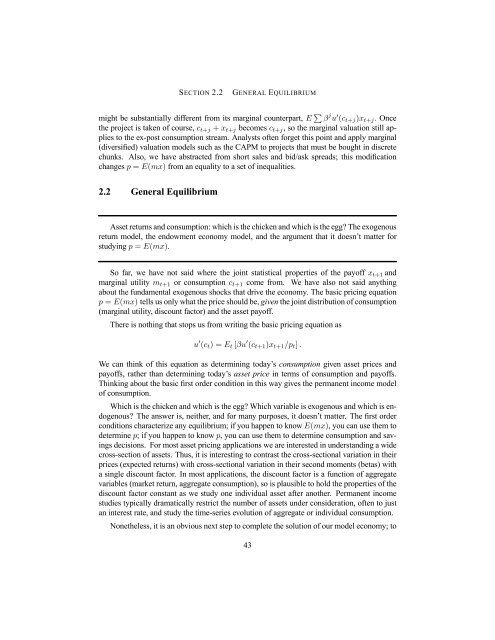Asset Pricing John H. Cochrane June 12, 2000
Asset Pricing John H. Cochrane June 12, 2000
Asset Pricing John H. Cochrane June 12, 2000
Create successful ePaper yourself
Turn your PDF publications into a flip-book with our unique Google optimized e-Paper software.
SECTION 2.2 GENERAL EQUILIBRIUM<br />
might be substantially different from its marginal counterpart, E P β j u 0 (ct+j)xt+j. Once<br />
the project is taken of course, ct+j + xt+j becomes ct+j, so the marginal valuation still applies<br />
to the ex-post consumption stream. Analysts often forget this point and apply marginal<br />
(diversified) valuation models such as the CAPM to projects that must be bought in discrete<br />
chunks. Also, we have abstracted from short sales and bid/ask spreads; this modification<br />
changes p = E(mx) from an equality to a set of inequalities.<br />
2.2 General Equilibrium<br />
<strong>Asset</strong> returns and consumption: which is the chicken and which is the egg? The exogenous<br />
return model, the endowment economy model, and the argument that it doesn’t matter for<br />
studying p = E(mx).<br />
So far, we have not said where the joint statistical properties of the payoff xt+1 and<br />
marginal utility mt+1 or consumption ct+1 come from. We have also not said anything<br />
about the fundamental exogenous shocks that drive the economy. The basic pricing equation<br />
p = E(mx) tells us only what the price should be, given the joint distribution of consumption<br />
(marginal utility, discount factor) and the asset payoff.<br />
There is nothing that stops us from writing the basic pricing equation as<br />
u 0 (ct) =Et [βu 0 (ct+1)xt+1/pt] .<br />
We can think of this equation as determining today’s consumption given asset prices and<br />
payoffs, rather than determining today’s asset price in terms of consumption and payoffs.<br />
Thinking about the basic first order condition in this way gives the permanent income model<br />
of consumption.<br />
Which is the chicken and which is the egg? Which variable is exogenous and which is endogenous?<br />
The answer is, neither, and for many purposes, it doesn’t matter. The first order<br />
conditions characterize any equilibrium; if you happen to know E(mx), you can use them to<br />
determine p; if you happen to know p, you can use them to determine consumption and savings<br />
decisions. For most asset pricing applications we are interested in understanding a wide<br />
cross-section of assets. Thus, it is interesting to contrast the cross-sectional variation in their<br />
prices (expected returns) with cross-sectional variation in their second moments (betas) with<br />
a single discount factor. In most applications, the discount factor is a function of aggregate<br />
variables (market return, aggregate consumption), so is plausible to hold the properties of the<br />
discount factor constant as we study one individual asset after another. Permanent income<br />
studies typically dramatically restrict the number of assets under consideration, often to just<br />
an interest rate, and study the time-series evolution of aggregate or individual consumption.<br />
Nonetheless, it is an obvious next step to complete the solution of our model economy; to<br />
43
















